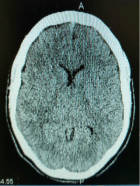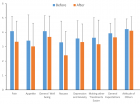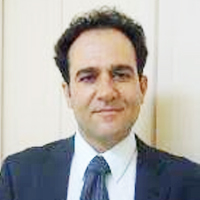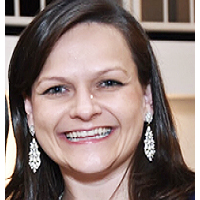Abstract
Research Article
The choice of optimal modern muscle relaxants (rocuronium bromide, atracurium besilate and cisatracurius besilate) in one-day surgery in children
Nasibova EM*
Published: 15 June, 2020 | Volume 4 - Issue 1 | Pages: 004-012
The choice of the optimal muscle relaxant in one-day surgery in children with “small” surgical interventions remains relevant to this day. In modern pediatric surgery, the requirements for the quality of muscle relaxation are highest. However, along with the effectiveness of the drug, its duration and controllability of the action, as well as the safety of use, are important [1-7].
The aim of the study: To determine the pharmacoeconomic rationale for the rational use of muscle relaxants, depending on the duration of operations in one-day surgery in children.
Material and research methods: The study was conducted in surgical clinics of the Azerbaijan Medical University. The study included 156 children who were operated on routinely from 0 to 16 years old (risk of anesthesia I-II ASA), who used combined endotracheal anesthesia during surgery. Based on the requirements of the GCP international program (Good Clinical Practice), the inclusion of children in the study was carried out only after the written consent of the parents. The studied patients were divided into 3 groups depending on the muscle relaxant used: IA (n = 52) - rocuronium bromide (esmeron), IB (n = 52) - atracurium besilate (tracrium), IC (n = 52) - cisatracurius besilate (nimbex). Depending on the type of general anesthesia, these groups were also divided into 2 subgroups: anesthesia based on isoflurane + fentanyl ″ + iso ″ and anesthesia based on sevoflurane + fentanyl ″ + sev ″. The main groups were also divided into 2 age subgroups: children under 2 years of age – IA1, IB1, IC1 and children from 2 to 16 years old – IA2, IB2, IC2.
Read Full Article HTML DOI: 10.29328/journal.ijcar.1001014 Cite this Article Read Full Article PDF
Keywords:
Ideal muscle relaxant; Rocuronium bromide; Atracurium besilate; Cisatracurium besilate
References
- Ali MZ, Ebied RS, Atallah MA, El Sabea HHA, El Monaemb AA, et al. Cisatracurium dose-response relationship in patients with chronic liver disease. Egy J Anaesthe. 2014; 30: 197-202.
- Alonso A, De Boer H, Booij L. Reversal of rocuronium-induced neuromuscular block by sugammadex in neonates. Eur J Anaesthesiol. 2014; 31: 163
- Bhananker SM, Treggiari MM, Sellers BA, Cain KC, Ramaiah R, et al. Comparison of train-of-four count by anesthesia providers versus TOF-Watch SX: a prospective cohort study. Can J Anesth. 2015; 62: 1089-1096. PubMed: https://www.ncbi.nlm.nih.gov/pubmed/26224034
- El-Kasaby M, Atef H, Helmy A, Abo El-Nas M. Cisatracurium in different doses versus atracurium during general anesthesia for abdominal surgery. Saudi J Anaesth. 2010; 4: 152-157. PubMed: https://pubmed.ncbi.nlm.nih.gov/21189851
- Kendrick J, Carr R, Ensom M. Pharmacokinetics and drug dosing in obese children. J Pediatr Pharmacol Ther. 2010; 15: 94-109. PubMed: https://www.ncbi.nlm.nih.gov/pmc/articles/PMC3018176/
- Meretoja O. Neuromuscular block and current treatment strategies for its reversal in children. Paediatr Anaesth. 2010; 20: 591-604. PubMed: https://pubmed.ncbi.nlm.nih.gov/20642658
- Mohamed N, Cynthia A. Lien: pharmacology of muscle relaxants and their antagonists chapter 29 / Ronald D. Miller’s Anaesthesia. Churchill Livingston. 2010: 868-890.
- Movafeghetal A. Cost analysis and safety comparison of Cisatracurium and Atracurium in patientsundergoing general anesthesia. European Review for Medical and Pharmacological Sciences. 2013; 17: 447-450. PubMed: https://pubmed.ncbi.nlm.nih.gov/23467941
- Naguib M. Neuromuscular blocking drugs and reversal agents / In: Flood P, Rathmell J, Shafer S. eds. Stoelting’s Pharmacology & Physiology in Anesthestic Practice. 5th ed. Philadelphia, PA: Wolters Kluwer Health. 2015: 323-344.
- Plaud B, Meretoja O, Hofmockel R, Raft J, Stoddart PA, et al. Reversal of rocuronium-induced neuromuscular blockade with sugammadex in pediatric and adult surgical patients. Anesthesiology. 2009; 110: 284-294. PubMed: https://pubmed.ncbi.nlm.nih.gov/19194156
- Shang G, Wang N, Qing Q, Jun G. Clinical pharmacology of cisatracurium during nitrous oxide-propofol anesthesia in children. J Clin Anesthe. 2008; 20: 411-414.
- Thilen S, Bhananker S. Qualitative neuromuscular monitoring: how to optimize the use of a peripheral nerve stimulator to reduce the risk of residual neuromuscular blockade. Curr Anesthesiol Rep. 2016; 6: 164-169. PubMed: https://www.ncbi.nlm.nih.gov/pmc/articles/PMC4963456/
- Todd M, Hindman B. The implementation of quantitative electromyographic neuromuscular monitoring in an academic anesthesia department: Follow-up observations. Anesth Analg. 2015; 121: 836-838. PubMed: https://www.ncbi.nlm.nih.gov/pubmed/26287308
- Zuche H, Morinello E, Viestenz A, Fiorentzis M, Seitz B et al. Reduction of intraocular pressure and ocular pulse amplitude during general anesthesia. Ophthalmology. 2015; 112: 764–769. PubMed: https://www.ncbi.nlm.nih.gov/pubmed/25510627
- J. Murray, H. DeBlock, B. Erstad, Gray AW Jr, Jacobi J, et al. Clinical practice guidelines for sustained neuromuscular blockade in the adult critically ill patient. Crit Care Med. 2016; 44: 2079–2103. PubMed: https://www.ncbi.nlm.nih.gov/pubmed/28069681
- Moss M, Huang DT, Brower RG, Ferguson ND, Ginde AA, et al. Early neuromuscular blockade in the acute respiratory distress syndrome. New Engl J Med. 2019; 380: 1997–2008. PubMed: https://pubmed.ncbi.nlm.nih.gov/31112383/
- Bouju P, Tadie JM, Barbarot N, Letheulle J, Uhel F, et al. Clinical assessment and train-of-four measurements in critically ill patients treated with recommended doses of cisatracurium or atracurium for neuromuscular blockade: a prospective descriptive study. Ann Intensive Care. 2017; 7: 10. PubMed: https://www.ncbi.nlm.nih.gov/pmc/articles/PMC5247382/
- Warr J, Thiboutot Z, Rose L, Mehta S, Burry JD, et al. Current therapeutic uses, pharmacology, and clinical considerations of neuromuscular blocking agents for critically ill adults. Ann Pharmacother. 2011; 45: 1116-1126. PubMed: https://www.ncbi.nlm.nih.gov/pubmed/21828347
- Lundstrøm LH, Duez CH, Nørskov AK, Rosenstock CV, Thomsen JL, et al. Avoidance versus use of neuromuscular blocking agents for improving conditions during tracheal intubation or direct laryngoscopy in adults and adolescents. The Cochrane database of systematic reviews. 2017. PubMed: https://www.ncbi.nlm.nih.gov/pubmed/28513831
- Palsen S, Wu A, Beutler SS, Gimlich R, Yang HK, et al. Investigation of intraoperative dosing patterns of neuromuscular blocking agents. J Clin Monitoring Computing. 2018. PubMed: https://www.ncbi.nlm.nih.gov/pubmed/30094585
Figures:

Figure 1

Figure 2

Figure 3

Figure 4

Figure 5

Figure 6

Figure 7

Figure 8

Figure 9

Figure 10
Similar Articles
-
The choice of optimal modern muscle relaxants (rocuronium bromide, atracurium besilate and cisatracurius besilate) in one-day surgery in childrenNasibova EM*. The choice of optimal modern muscle relaxants (rocuronium bromide, atracurium besilate and cisatracurius besilate) in one-day surgery in children. . 2020 doi: 10.29328/journal.ijcar.1001014; 4: 004-012
Recently Viewed
-
Closure of Post-infarct Basal Ventricular Septal Defect by Using an Atrial Septal Defect Closure Device: A Case ReportCeyhun Gökhan*,Arslan Ümit,Dursun Lezgin,Aydin Muhammet,Şeker Cüneyt. Closure of Post-infarct Basal Ventricular Septal Defect by Using an Atrial Septal Defect Closure Device: A Case Report. J Clin Med Exp Images. 2024: doi: 10.29328/journal.jcmei.1001033; 8: 013-016
-
Bipolar and Goldenhar: A Case Report of Bipolar Disorder with Psychotic Features in a Man with Goldenhar SyndromeMahin Eslami Shahrbabaki, Roya Pooyanfard*, Mohammadamin Abdi*. Bipolar and Goldenhar: A Case Report of Bipolar Disorder with Psychotic Features in a Man with Goldenhar Syndrome. Arch Case Rep. 2023: doi: 10.29328/journal.acr.1001074; 7: 035-037
-
Regional Anesthesia Challenges in a Pregnant Patient with VACTERL Association: A Case ReportUzma Khanam*,Abid,Bhagyashri V Kumbar. Regional Anesthesia Challenges in a Pregnant Patient with VACTERL Association: A Case Report. Int J Clin Anesth Res. 2025: doi: 10.29328/journal.ijcar.1001027; 9: 010-012
-
Evolution of Antifungal Activity of Artemisia herba-alba Extracts on Growth of Aspergillus sp. and Rhizopus sp.Eman MG Gebreil,Nagwa SA Alraaydi,Saleh HM EL-Majberi,Idress Hamad Attitalla*. Evolution of Antifungal Activity of Artemisia herba-alba Extracts on Growth of Aspergillus sp. and Rhizopus sp.. Int J Clin Microbiol Biochem Technol. 2025: doi: 10.29328/journal.ijcmbt.1001030; 8: 001-006
-
The Role of Mitochondria in Chronic Wound Healing (Mitotherapy): Signaling and Therapeutic ImplicationsSeyedeh Sara Azadeh*,Hoda Keshmiri Neghab. The Role of Mitochondria in Chronic Wound Healing (Mitotherapy): Signaling and Therapeutic Implications. Arch Biotechnol Biomed. 2025: doi: 10.29328/journal.abb.1001043; 9: 001-009
Most Viewed
-
Evaluation of Biostimulants Based on Recovered Protein Hydrolysates from Animal By-products as Plant Growth EnhancersH Pérez-Aguilar*, M Lacruz-Asaro, F Arán-Ais. Evaluation of Biostimulants Based on Recovered Protein Hydrolysates from Animal By-products as Plant Growth Enhancers. J Plant Sci Phytopathol. 2023 doi: 10.29328/journal.jpsp.1001104; 7: 042-047
-
Sinonasal Myxoma Extending into the Orbit in a 4-Year Old: A Case PresentationJulian A Purrinos*, Ramzi Younis. Sinonasal Myxoma Extending into the Orbit in a 4-Year Old: A Case Presentation. Arch Case Rep. 2024 doi: 10.29328/journal.acr.1001099; 8: 075-077
-
Feasibility study of magnetic sensing for detecting single-neuron action potentialsDenis Tonini,Kai Wu,Renata Saha,Jian-Ping Wang*. Feasibility study of magnetic sensing for detecting single-neuron action potentials. Ann Biomed Sci Eng. 2022 doi: 10.29328/journal.abse.1001018; 6: 019-029
-
Pediatric Dysgerminoma: Unveiling a Rare Ovarian TumorFaten Limaiem*, Khalil Saffar, Ahmed Halouani. Pediatric Dysgerminoma: Unveiling a Rare Ovarian Tumor. Arch Case Rep. 2024 doi: 10.29328/journal.acr.1001087; 8: 010-013
-
Physical activity can change the physiological and psychological circumstances during COVID-19 pandemic: A narrative reviewKhashayar Maroufi*. Physical activity can change the physiological and psychological circumstances during COVID-19 pandemic: A narrative review. J Sports Med Ther. 2021 doi: 10.29328/journal.jsmt.1001051; 6: 001-007

HSPI: We're glad you're here. Please click "create a new Query" if you are a new visitor to our website and need further information from us.
If you are already a member of our network and need to keep track of any developments regarding a question you have already submitted, click "take me to my Query."


















































































































































